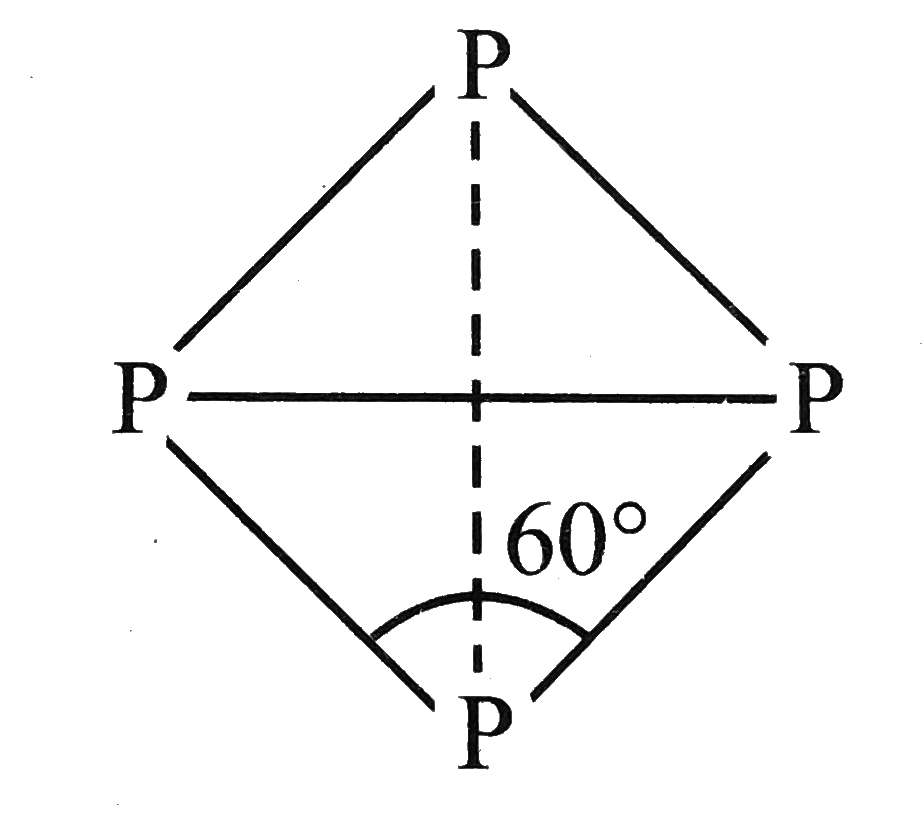Most of the polyatomic molecules except a few such as CO2 and CS2 are linear or angular with a bond angle generally somewhat greater than 90∘ A bond angle is defined as the angle between the direction of two covalent bonds Since the atoms in molecules are in constant motion with respect to each other they are not expected to have a fixed value of bond angle Repulsion between non-bonded atoms alone does not provide an adequate explanation Hybridisation of bonding orbitals an adequate explanation Hybridisation of bonding orbitals also plays a very important role in detrmining the value of bond angle It has been observed that in hybridisation as the s-character of hybrid orbital increases the bond angle increases
In P4 molecule phosphorous atoms are tetrahedrally arranged The angle P−P−P in the molecule is .
A
108∘
B
120∘
C
60∘
D
180∘
Video Solution
Text Solution
The correct Answer is:C
The structure of P4 molecules is
Therefore the P−P−P bond angle is 60∘
 .
.
|
Topper's Solved these Questions
- CHEMICAL BONDING AND MOLECULAR STRUCTUREBOOK - CENGAGE CHEMISTRYCHAPTER - CHEMICAL BONDING AND MOLECULAR STRUCTUREEXERCISE - Exercises Multiple Correct(Chemical Bonding )
7 Videos
- CHEMICAL BONDING AND MOLECULAR STRUCTUREBOOK - CENGAGE CHEMISTRYCHAPTER - CHEMICAL BONDING AND MOLECULAR STRUCTUREEXERCISE - Exercises Multiple Correct (Dipole Moment)
3 Videos
- CHEMICAL BONDING AND MOLECULAR STRUCTUREBOOK - CENGAGE CHEMISTRYCHAPTER - CHEMICAL BONDING AND MOLECULAR STRUCTUREEXERCISE - Ex 2 .2 Objective
34 Videos
- ATOMIC STRUCTUREBOOK - CENGAGE CHEMISTRYCHAPTER - ATOMIC STRUCTUREEXERCISE - Concept Applicationexercise(4.3)
19 Videos
- CHEMICAL EQUILIBRIUMBOOK - CENGAGE CHEMISTRYCHAPTER - CHEMICAL EQUILIBRIUMEXERCISE - Archives (Subjective)
11 Videos
Similar Questions
Knowledge Check
Most of the polyatomic molecules except a few such as CO2 and CS2 are linear or angular with a bond angle generally somewhat greater than 90∘ A bond angle is defined as the angle between the direction of two covalent bonds Since the atoms in molecules are in constant motion with respect to each other they are not expected to have a fixed value of bond angle Repulsion between non-bonded atoms alone does not provide an adequate explanation Hybridisation of bonding orbitals an adequate explanation Hybridisation of bonding orbitals also plays a very important role in detrmining the value of bond angle It has been observed that in hybridisation as the s-character of hybrid orbital increases the bond angle increases
Which of the following have highest bond angle ? .AH2SBH2TeCH2SeDAll have same bond angleMost of the polyatomic molecules except a few such as CO2 and CS2 are linear or angular with a bond angle generally somewhat greater than 90∘ A bond angle is defined as the angle between the direction of two covalent bonds Since the atoms in molecules are in constant motion with respect to each other they are not expected to have a fixed value of bond angle Repulsion between non-bonded atoms alone does not provide an adequate explanation Hybridisation of bonding orbitals an adequate explanation Hybridisation of bonding orbitals also plays a very important role in detrmining the value of bond angle It has been observed that in hybridisation as the s-character of hybrid orbital increases the bond angle increases
Which of the following hybridisation may have more than one type of bond angle ? .Asp2Bsp3Csp3dDsp3d2The bond angle in XeF2 molecule is
A120∘B109∘C180∘D90∘
In which of the following is the angle between the two covalent bonds greatest
View SolutionBond angle in NH3 molecule is
View SolutionBond angle in H2S molecule is
View SolutionThe angle between the covalent bonds is maximum in :
View SolutionIn which of the following the angle between the two covalent bonds is largest?
View Solution
